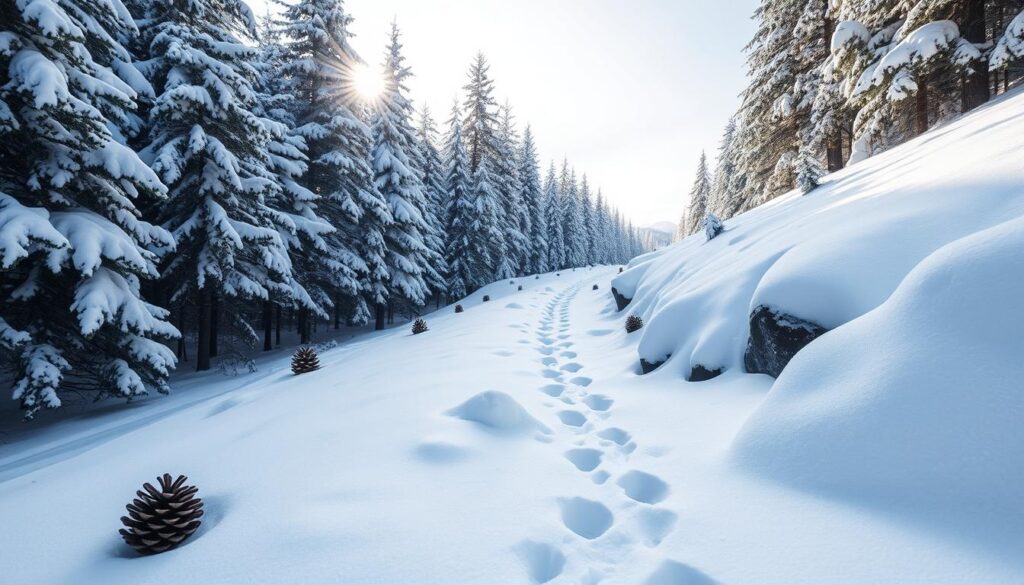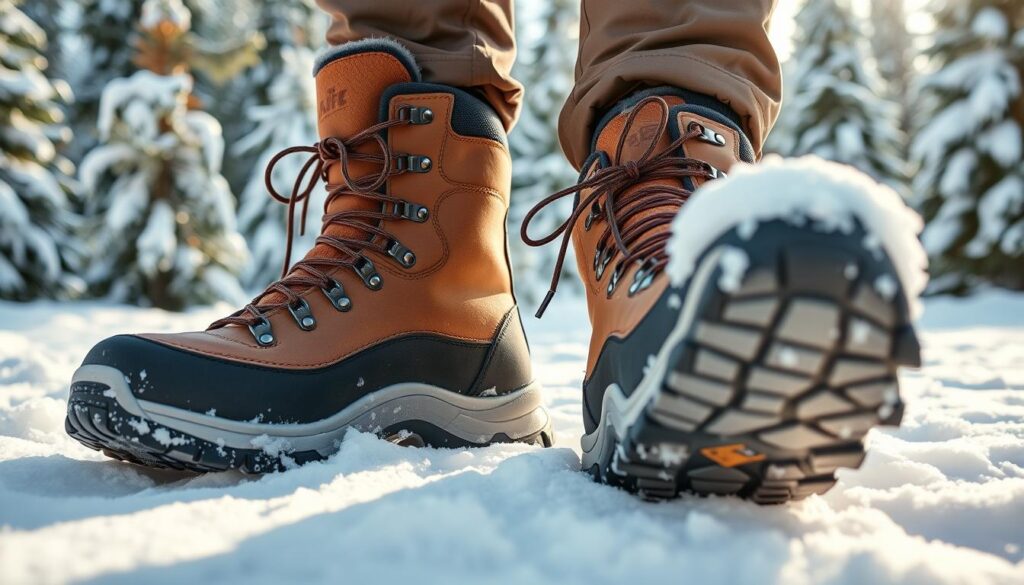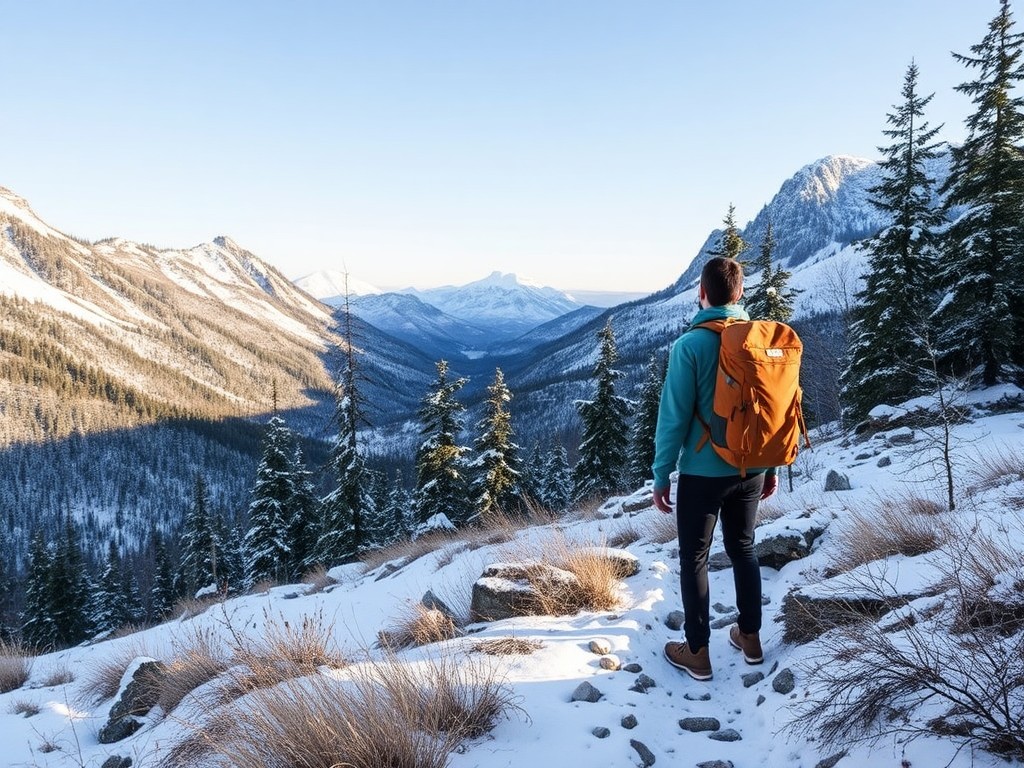As winter comes, the call of winter hiking grows stronger. Hiking in the snow can be thrilling and rewarding. But, it also brings challenges for newbies. We’ll share key tips and techniques for a safe and fun first winter hike.

Table of Contents
Understanding Winter Hiking and Snow Travel Basics
Winter hiking in the snow needs special skills and knowledge. As you start your winter trek, knowing the terrain, physical demands, and best times is key.
Different Types of Winter Terrain
The winter landscape is diverse and changes often. You’ll face different terrains like packed snow, deep powder, and icy paths. Knowing these differences helps you stay safe while hiking in the snow.
Physical Demands of Snow Hiking
Winter hiking is harder than summer hikes. You’ll carry more gear, face snow resistance, and need to stay balanced. Getting ready physically and mentally is important for a good winter hike.
Best Times for Winter Hiking
Choosing the right time for winter hiking is important. The best times are during the shoulder seasons when the snow is stable. Watching the weather and daylight helps plan your winter hikes.
“Embrace the winter wonderland, but do so with the proper knowledge and preparation to ensure a safe and fulfilling snow travel experience.”
Essential Winter Hiking Gear and Equipment
Winter hiking needs special gear for safety, comfort, and fun. The right stuff, like insulated jackets and sturdy boots, makes a big difference. Let’s check out the must-haves for snowy trails.
Insulated Jackets and Pants
Staying warm and dry is key in winter. Choose insulated jackets and waterproof pants to fight off the cold. Look for down or synthetic insulation and adjustable hoods and cuffs to keep the heat in.
Gaiters and Gloves
Warm hands and feet are important. Gaiters keep snow out of your boots. Insulated gloves keep your hands toasty.
Specialized Equipment
- Ice axes and crampons help on icy or steep paths.
- Snowshoes or skis are needed for deep snow.
- A headlamp or flashlight is vital for short winter days.
Quality cold weather hiking gear and winter hiking clothing are crucial. With the right gear, you’re ready for snowy trails and a great winter hike.
Winter Hiking Clothing: Layering for Success
Staying warm and comfortable on winter hikes is key. The art of layering your clothes is crucial. It helps keep your body warm and lets it adjust its temperature.
Base Layer Selection
The base layer is the start of your winter hiking outfit. It should be made of moisture-wicking fabrics like synthetic or merino wool. These fabrics pull sweat away from your skin.
Stay away from cotton because it holds onto moisture. This makes you feel cold and wet. Pick a base layer that fits well but doesn’t limit your movement.
Insulation Layer Guidelines
The insulation layer keeps you warm by trapping heat. It can be a lightweight fleece, a mid-weight jacket, or a down-filled puffer. The right choice depends on the weather and how cold you get.
Choose a breathable layer that lets you move easily. This is important for your comfort.
Outer Shell Requirements
The outer shell protects you from wind, rain, and snow. Look for a waterproof and breathable jacket and pants. Materials like Gore-Tex are good choices.
This layer should fit over your base and insulation layers. It lets you adjust your clothes as the weather changes.
| Layer | Purpose | Fabric Recommendations |
|---|---|---|
| Base Layer | Moisture-wicking, next-to-skin comfort | Synthetic, merino wool |
| Insulation Layer | Trapping heat, maintaining core body temperature | Fleece, down, synthetic insulation |
| Outer Shell | Protection from wind, rain, and snow | Waterproof and breathable fabrics like Gore-Tex |
By using the three-layer system, you can stay warm and dry on winter hikes. Quality winter hiking clothing and cold weather hiking gear are key for a great experience.
Footwear and Traction: Choosing the Right Snow Hiking Boots
Your choice of snow hiking footwear is key for winter trekking. The right boots keep your feet warm, dry, and secure on snowy trails. Here are some factors to consider for the perfect snow hiking footwear.
Insulation and Waterproofing
Boots with good insulation keep your feet warm. A waterproof and breathable membrane, like Gore-Tex®, keeps your feet dry. This is important for snowy and wet conditions.
Traction and Stability
The soles of your boots need aggressive lugs and deep treads for grip. A sturdy, rigid sole helps with stability on uneven terrain. It also prevents ankle rollovers.
Fit and Support
Make sure boots fit well with the socks you’ll wear. They should be snug but not too tight. Look for ankle support and cushioned midsoles for comfort during long hikes.
Adding traction devices like microspikes or snowshoes can help. The right boots and accessories prepare you for winter’s challenges. You’ll enjoy the beauty of snowy landscapes.
| Feature | Importance for Snow Hiking |
|---|---|
| Insulation | Crucial for keeping feet warm in cold temperatures |
| Waterproofing | Essential for keeping feet dry in snow and melting conditions |
| Traction | Necessary for secure footing on slippery, icy, and snowy surfaces |
| Fit and Support | Important for comfort, stability, and preventing fatigue during long hikes |

Investing in the right snow hiking footwear is key for winter trekking. It makes your hiking experience safe and enjoyable. Take time to find the perfect boots for your adventures.
Winter Hiking, Snow Hiking Tips: Safety Guidelines and Best Practices
Exploring the winter wilderness is thrilling but needs careful planning and safety knowledge. For snow travel safety and winter backcountry survival, several key points must be considered.
Navigation in Snow Conditions
Traveling through snow can be challenging, even for seasoned hikers. Learn to use a compass, map, and GPS to stay on track. Don’t count on landmarks too much, as snow and weather can hide them.
Weather Monitoring
Keeping an eye on the weather is vital for a safe winter hike. Always check forecasts and be ready to change your plans if needed. Quick weather changes can make a good hike dangerous.
Emergency Protocols
Having a solid emergency plan is crucial. Carry a first-aid kit, emergency shelter, and ways to signal for help. Learn basic survival skills like starting a fire and building a snow shelter. Knowing how to handle emergencies will keep you safe.
By following these snow travel safety and winter backcountry survival tips, you’ll enjoy winter hiking more. Always put safety first when venturing into the snow.
Nutrition and Hydration for Cold Weather Hiking
Going on a winter hike means you need to think about what you eat and drink. Your body uses more energy to stay warm in the cold. It’s also harder to stay hydrated.
Choose snacks that are full of nutrients and calories to keep you going. Trail mix, energy bars, and dried fruit are great because they’re easy to eat and won’t freeze. Don’t just drink water, as it can freeze. Instead, carry a thermos of hot tea, coffee, or broth.
- Prioritize high-calorie, nutrient-dense snacks like trail mix, energy bars, and dried fruit.
- Bring a thermos of hot beverages to avoid frozen water bottles.
- Consume enough calories to compensate for the increased energy expenditure in cold weather.
Good nutrition and hydration are key to keeping your energy up and staying safe. With the right gear, you can enjoy your winter hike without worries.
“Staying hydrated and fueled is just as important in the winter as it is in the summer – perhaps even more so.” – Outdoor Adventurer
Advanced Snow Travel Techniques and Trail Navigation

Exploring the winter world of snowshoe hiking or winter trekking needs more than basic skills. To travel safely and efficiently, learning advanced snow travel techniques and trail navigation is key. Let’s look at some important strategies to improve your snow hiking experience.
Using Trekking Poles
Trekking poles are great helpers on snowy paths. They help with stability, balance, and moving forward. When walking in deep snow, push the poles into the snow to spread your weight and help with each step. Make sure the pole length fits your stride and the terrain for the best use of energy.
Reading Snow Conditions
Learning to read snow conditions is vital for winter trekkers. Look at the snow’s texture, depth, and how packed it is to find the best path and avoid dangers. Soft, fluffy snow needs more effort to walk through, while denser snow is more stable. Knowing these differences helps you make smart choices and stay safe.
Trail Breaking Methods
Leading the way in deep snow can be hard work. Use effective trail breaking methods to save energy and keep a steady pace. Share the lead role in your group to give everyone a break. When leading, use a shuffling or “kick-step” motion to make a path for others to follow.
Learning these advanced techniques and trail navigation skills will make your winter hiking better. It will make your adventures more fun, efficient, and safe. Take on the challenge and watch your snowshoe hiking or winter trekking skills grow.
Planning Your First Winter Hiking Adventure
Starting your first winter hike is exciting and rewarding. But, it needs careful planning and preparation. Choose a trail that fits your skill level and the snow conditions. Look at local hiking forums and talk to outdoor outfitters for safe routes.
Make a detailed list of what gear you need. This includes warm clothes, strong boots, and tools for walking on snow. Also, remember to pack a first-aid kit, fire starters, and extra food and water. Learn how to use snowshoes or crampons properly.
Check the avalanche forecast and trail conditions before you go. Knowing the weather and any storms can help you plan better. With safety first and good preparation, your first winter hike will be memorable.
FAQ
What are the different types of winter terrain I may encounter during snow hiking?
You might find packed snow, deep powder, and icy paths. Knowing these surfaces helps you stay safe and choose the right gear.
How physically demanding is snow hiking compared to hiking in warmer seasons?
Snow hiking is much harder than hiking in warm weather. The snow’s weight and resistance make it more challenging. Be ready for the extra effort.
What are the best times of year for winter hiking?
The best times are usually December, January, and February. The snow is stable, and the weather is more predictable. It’s also when it’s colder and daylight is shorter.
What are the essential pieces of winter hiking gear and equipment I need to stay safe and comfortable?
You’ll need an insulated jacket, waterproof pants, and gaiters. Also, don’t forget ice axes and crampons. The right gear keeps you warm and safe.
How should I layer my clothing for optimal winter hiking performance?
Use a layering system for cold weather. Start with a moisture-wicking base layer. Add an insulating layer, then a waterproof outer shell. This lets you adjust to changing conditions.
What type of footwear and traction devices do I need for snow hiking?
Choose winter hiking boots that are insulated, waterproof, and have good grip. Consider microspikes or snowshoes for extra traction.
What are some important safety guidelines and best practices for winter hiking?
Know how to navigate in snow, watch the weather, and have emergency plans. Be aware of avalanche risks and have survival skills.
How do I properly fuel and hydrate for cold weather hiking?
Eat energy-rich snacks and keep water from freezing. Stay hydrated and listen to your body’s cold-weather needs. This helps prevent hypothermia.
What are some advanced snow travel techniques and trail navigation skills?
Use trekking poles, read snow conditions, and learn efficient trail breaking. These skills improve your safety and experience in winter.
How do I plan my first winter hiking adventure?
Research beginner trails, check the weather and trail conditions, and make a gear list. Start with short, easy trails and build your experience.
